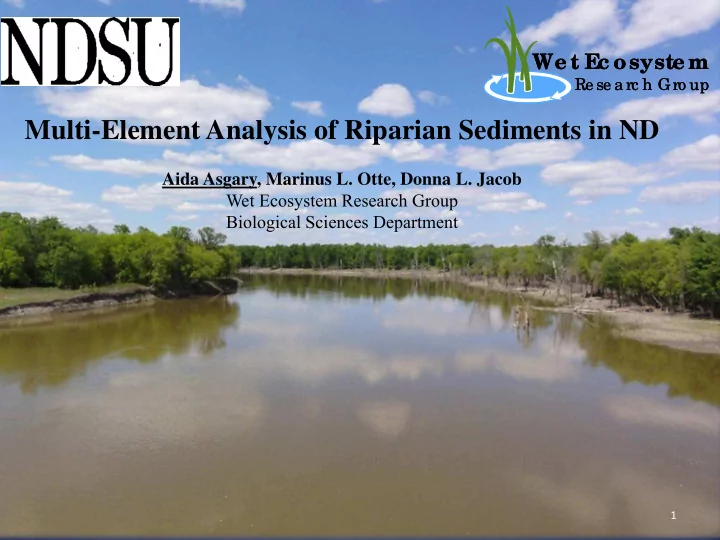

We t E We t E c osyste m c osyste m Re se a rc h Gro up Re se a rc h Gro up Multi-Element Analysis of Riparian Sediments in ND Aida Asgary, Marinus L. Otte, Donna L. Jacob Wet Ecosystem Research Group Biological Sciences Department 1
Introduction Sediments are chemically heterogeneous. • Transfer nutrients, metals and organics. • Sediment fingerprinting method: chemical and physical properties of the • transported sediment reflect those of the source. Sediment deposits Sediment deposits Sediment depositions , Missouri River, ND 2
Introduction Little Missouri Red Missouri Sheyenne James Little Missouri Red Missouri Sheyenne James Land cover, geology, pH, turbidity and sediment-water chemistry impact the variations and distributions in plant communities. 3
Purpose of Riparian Study Study and survey the element distribution and patterns at the rivers and • riparian sediments in North Dakota. Investigate links between land use activities in the region and the current • conditions of the wetlands. Address the tributaries and sources that contribute the most to the • concentrations of particular elements. 4
Study Area and Sampling (2011 ) D D D C C C A A A A A A D D D B B B A A A C C C B B B B B B B B B D D D C C C A A A B B B D D D C C C A A A C C C D D D 5
Results 2011 Significant variations in element concentrations between the Rivers, ND 2000 1800 1600 1400 1200 Ca(µmol/g) Red 1000 Sheyenne Jemes 800 Missouri 600 Little Missouri 400 200 0 0 200 400 600 800 1000 1200 1400 Mg (µmol/g) Out of the 56 elements, 47 showed Red, James and Sheyenne Rivers are • • statistically significant difference (p-value≤ similar in concentrations for 24 elements 6 0.001) between the rivers !
Results 2011 Significant variations in particle size (f<63µm) between the River s, ND 100 90 Particle size (%f<63µm) 80 70 60 50 40 30 20 10 0 Little Missouri Missouri James Sheyenne Red 7
Results 2012 Percentage contribution of Sheyenne and Turtle to the cadmium and selenium concentrations at the Red River 1 0.9 0.8 0.7 0.6 0.5 Sheyenne Turtle 0.4 0.3 0.2 0.1 0 Cd(µmol/g) Se(µmol/g) 8
Conclusion This study have shown that there is a considerable variation in element • concentrations in the sediments of the Red, Sheyenne, James, Missouri and Little Missouri. Geology and land use in the area could be the possible factors impacting • variations. Tributaries showed significant contributions, and element-fingerprinting • method could be applied for the sediment source tracing. 9
Acknowledgments Funding: EPA project FAR 0017348. • ND INBRE: National Center for Research Resources (5P20RR016471-12), • National Institute of General Medical Sciences (8 P20 GM103442-12) from the National Institutes of Health . • Advisors: Marinus Otte, Donna Jacob • Grad Students : La Toya Kissoon, Alex Yellick, Carrie Werkmeister-Karki, Alex Stalboerger. Khurram Sheikh • Undergrad Students: Ryan Sullivan, Emily Fischbach, Hannah Passolt, Candace Craft, John Schmidt, Alex Hoehle, Aude Monthean. Nicholas Peterson, Yiqing Xu, Bryan Marquardt 10
Recommend
More recommend